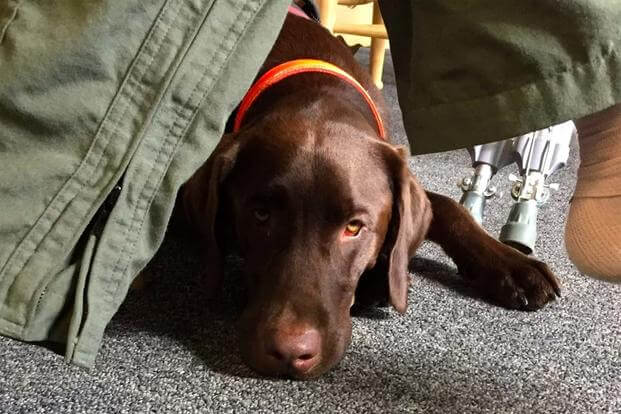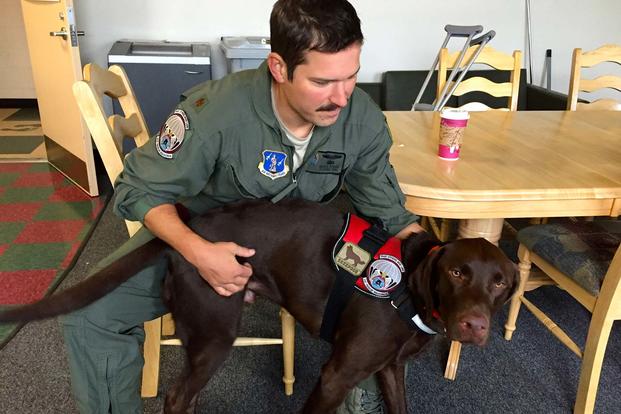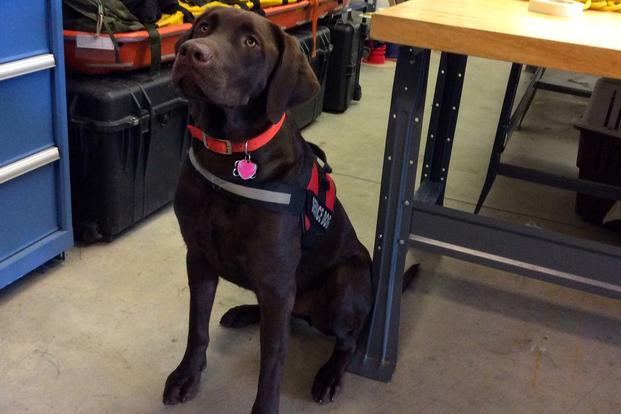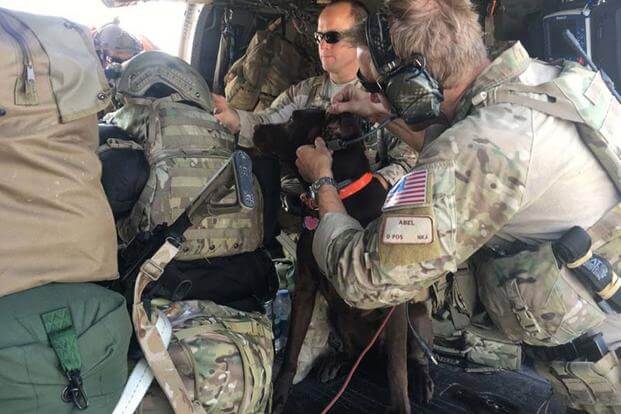JOINT BASE ELMENDORF-RICHARDSON, Alaska -- In the high-stress world of Alaska's Air National Guard rescue squadron "PJs," who respond to emergencies around the state and deploy overseas, it can be hard to deal with the mental tolls that come with the job.
But one member of the pararescue unit is a trained expert in knowing when someone on the team needs extra help, and he's believed to be the first of his kind in the U.S. military.
Instead of a flight suit or airman battle uniform, he simply wears a vest.
TOML, a one-year-old chocolate Labrador, joined the Alaska Air National Guard's 212th Rescue Squadron in 2016 and then deployed to Afghanistan with them. His name is the acronym for the pararescue community's motto, "That Others Might Live."
Related Video:
When he passes his final test, which his trainer said will be scheduled soon, TOML’s ownership will officially be transferred to the unit from the non-profit organization that donated and trained him.
Although working dogs are common across the military, none is known to both officially belong to the unit and hold a service animal-specific role.
Related content:
- Video: Celebration of Life for Military Service Dog Cena
- Service Dogs and Other Lesser-Known VA Benefits
- Video: Giants Surprise Veteran With Service Dog
Some unit chaplains, such as one Army chaplain stationed in Germany, own service animals that move with them across assignments.
And many units, such as 1st Brigade, "Bastogne," of the 101st Infantry Division at Fort Campbell, Kentucky, have mascot animals.
But officials with the 212th said they do not know of any other unit that has its own service dog.
The Army-directed Human Animal Bond program governs how these animals are cared for, and veterinary services and a care budget are provided through the Pentagon, unit officials said.
"I have yet to hear -- and I do a lot of research on this -- of any actual service dog for a unit deploying with them," said TOML's trainer April Gettys, founder of the non-profit Midnight Sun Service Dogs in Eagle River, Alaska, who facilitated the donation of the dog to the unit.
Gettys' husband, Air Guard Brig. Gen. Blake Gettys, is the joint staff director of the Alaska Guard's Joint Force Headquarters here.
TOML is what's known as a "facility animal," and trained as a service dog for multiple handlers.
He also can perform animal therapy functions and is being trained to do other working dog tasks, such as making jumps with a handler to assist in rescues. TOML is worth about $45,000, Gettys said.
"We're the dirty end of the business -- the stress of being alert non-stop, 24/7 and always being prepared ... and that adds a lot of stress. And then the stress of seeing people blown up and shredded and all that stuff," said Air National Guard Maj. Brock Roden, one of the handlers. "TOML is a part of that whole focus of the squadron, taking care of our members."
TOML responds to and works as a service dog for whichever handler he's been assigned to for the day, officials said.
His care and job rotates through the unit, and handlers can request time with him as desired.
Although there are plans to train the entire 60-member unit, about 10 members have gone through the handler training so far and can "check him out" to take him home and keep him during the day.
Although not typical for most service dogs, shuffling between handlers is not stressful on TOML, Gettys said, because he's been trained for it.
He has his own bed and "go bag" packed with brushes, toys, training treats, a medical kit and his journal, Roden said.
The handlers use the journal to log any new commands he's learning, medical events, or anything else important to pass on to the next person.
Unlike active-duty units, members of the 212th could be in the unit for their entire careers, thanks to the stability afforded by the Guard.
That means that a unit-owned service animal is a long-haul benefit -- and tasking -- for everyone involved.
Before agreeing to add TOML to the unit, Roden said his commander had a "talk" with the unit, not unlike the discussion parents have with their kids before agreeing to buy them a new pet.
"Our chief was like, 'This is a long-term commitment, it's multiple years and someone is going to have it every single day,' " he said.
TOML has inspired at least three other units to work with Gettys to get their own facility service dogs.
Three members of the 212th have received their own individual service dogs since TOML joined the unit, and four others are in the process, she said.
"You think there's one dog -- look how many lives he is affecting," Gettys said.
-- Amy Bushatz can be reached at amy.bushatz@military.com.

































